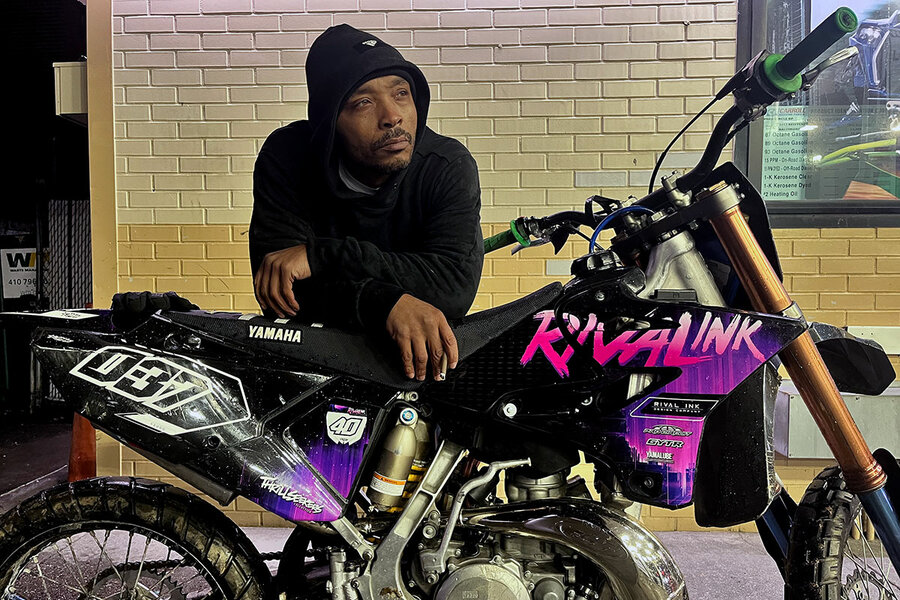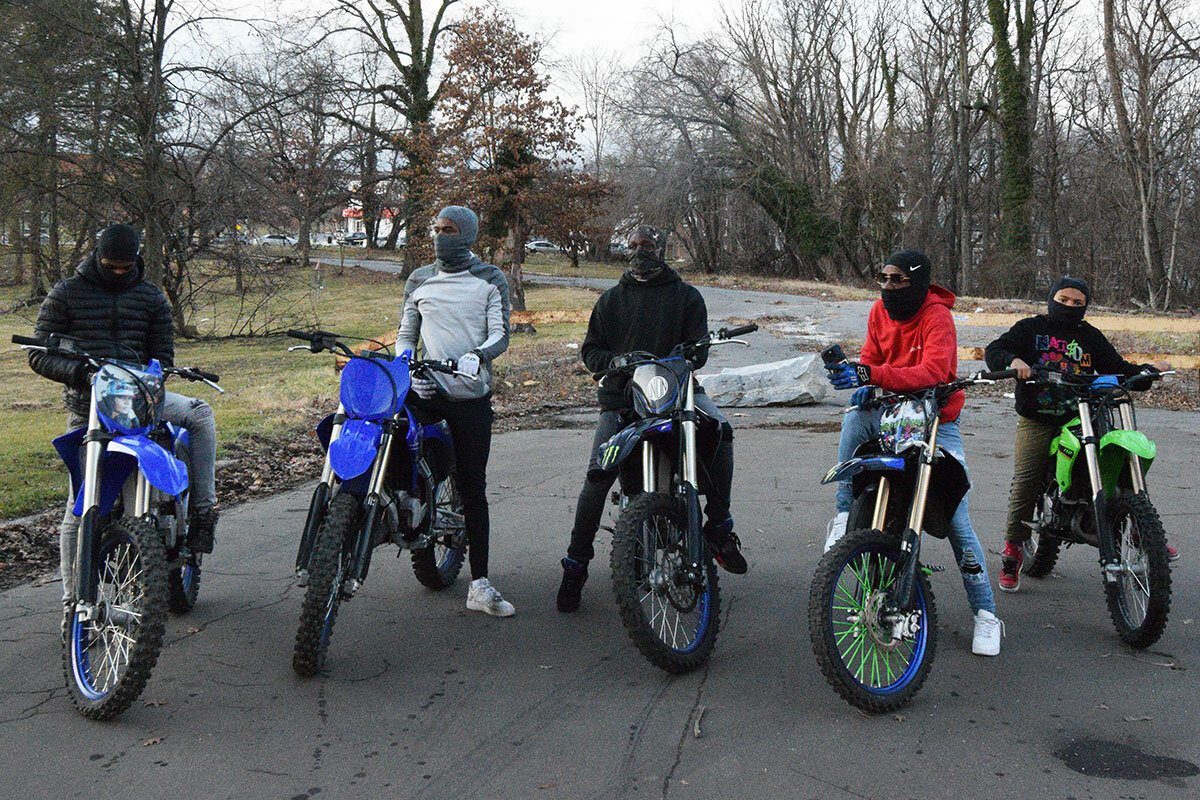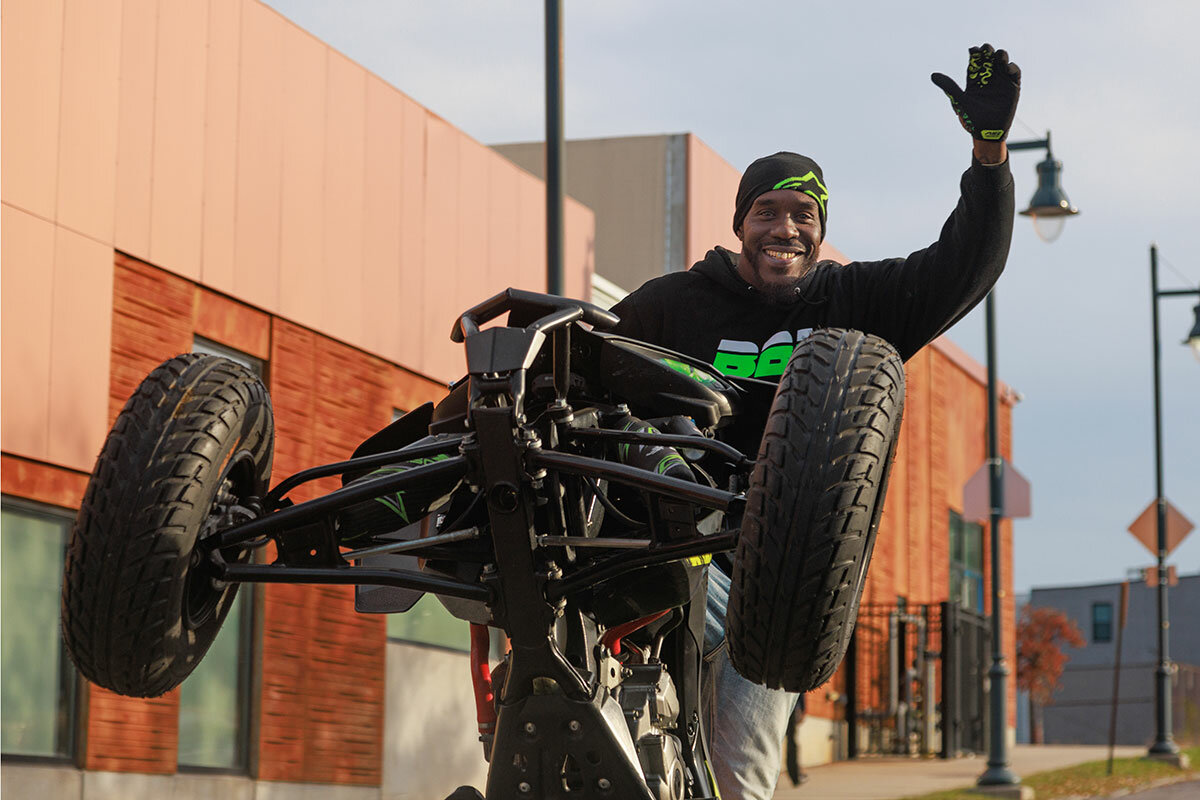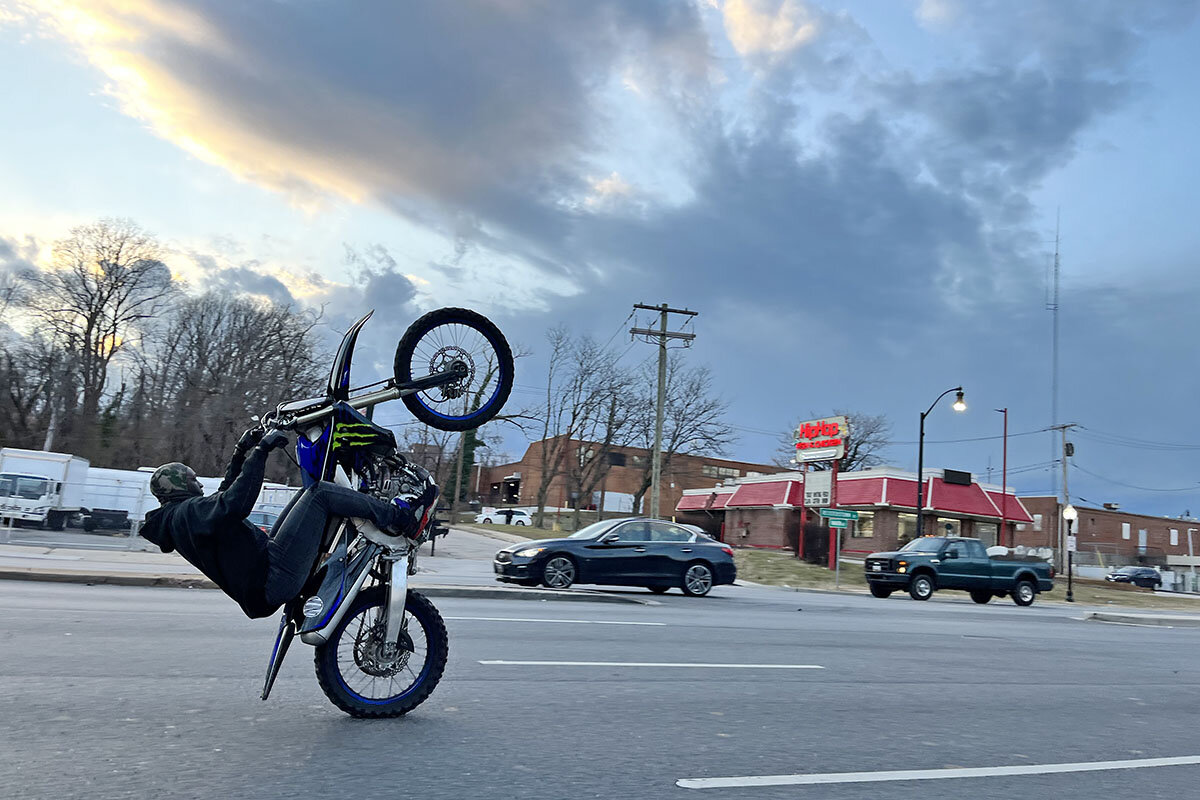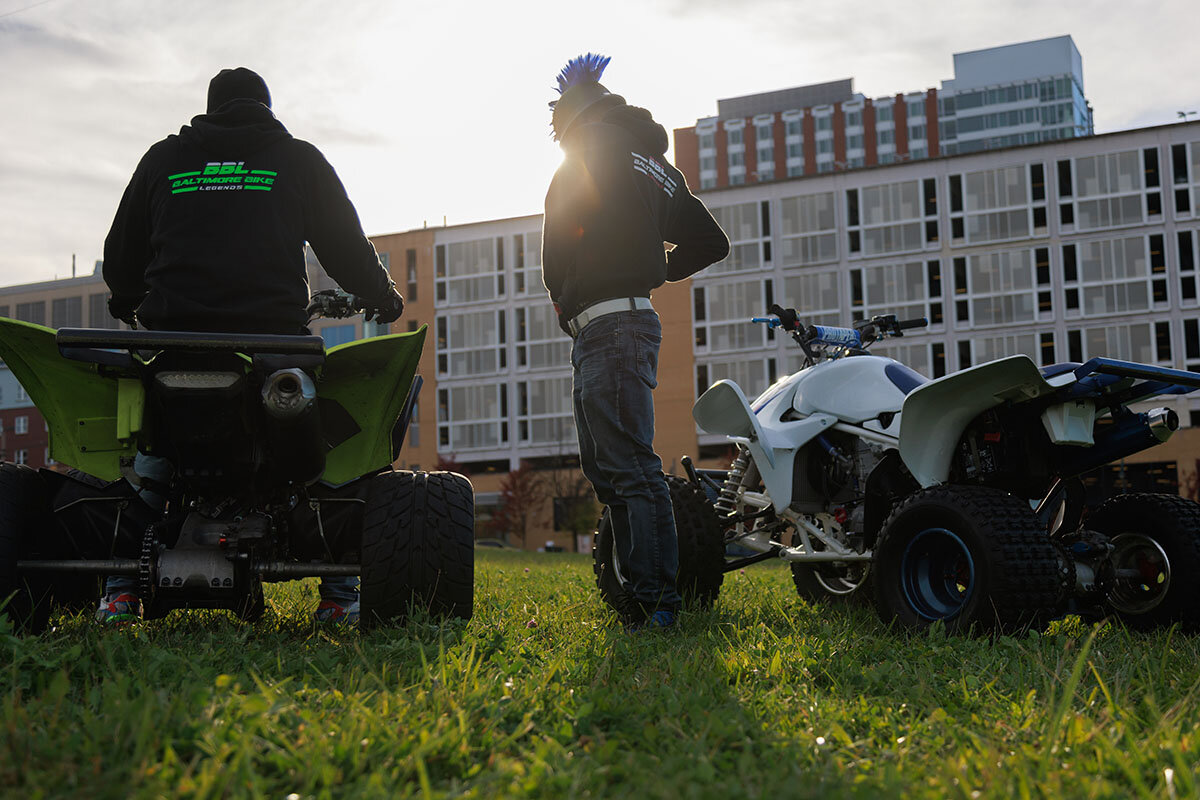Urban dirt biking: Riding the line between culture and crime
Loading...
| Baltimore
At the head of a pack of half a dozen roaring dirt bikers darting down Baltimore’s busy Reisterstown Road, a man known as “Neighborhood Hero” sees an opening in traffic and pulls into a clear lane. He pops a wheelie at 20 mph and waves at onlookers before pulling his front wheel even higher into the air – leaning so far back that he trails a gloved hand behind him on the ground, wet with light rain. Dropping the front wheel to the pavement, he triumphantly rockets forward into traffic.
Neighborhood Hero, astride his unlicensed, four-stroke Yamaha, rides a blurry, complicated line between cultural expression and criminal behavior. He’s part of the “bike life” culture, comprised mostly of young people of color riding off-road dirt bikes and all-terrain vehicles (ATVs) illegally on major roads and back alleys – sometimes even in parks – from New York City to Los Angeles to Paris.
Bike lifers and some familiar with their sport say that riding helps build community and gives young people an outlet that keeps them out of the fray of drug trafficking and gang violence. Detractors say riding off-road vehicles on city streets is loud, violent, and dangerous enough that – occasionally – people die.
Why We Wrote This
A story focused onSemi-outlaw sports like skateboarding and parkour found increasing acceptance – and space to play. Now urban dirt bikers are seeking acceptance and a place for their sport.
“This is a problem that a lot of major cities face,” says Lt. Christopher Warren, who led a Baltimore Police Department dirt bike task force between 2016 and 2020. But, he adds, it’s not a crime cities want to imprison people for.
Comparisons to extreme sports of rebellion
Dirt biking is no different from skateboarding, extreme skiing, parkour, or even the subculture of gaming, says Malcolm Drewery, a sociology professor at the department of applied social and political sciences at Coppin State University – just blocks from that Reisterstown Road stretch called “The Wheel Deal” by bikers. “All of those have been given safe, legal spaces,” he adds.
While there are dirt bike and motocross tracks in suburbs of many cities, including Baltimore, access is limited to people who have the resources to trailer their dirt bikes to the track, says Dr. Drewery.
Some young people might still choose an open street over a separate course because they want an audience, says Johnny Rice, an assistant professor of criminal justice at Coppin State University. Someone might think, “because I’m not part of the crime and violence in Baltimore, I should be allowed to do this,” he says.
The urban dirt biking debate has simmered over at least three decades since the culture began forming in the late 1980s, boiling over when someone is injured or killed in an accident, or when riders set out to intimidate or assault drivers or taunt police. In November, a man was dragged from his car in New York’s Harlem and beaten by a group of riders. He died from his injuries. Dirt biking in Philadelphia led to several violent incidents in the fall, including one in which a dirt biker threw a brick at a marked police cruiser, breaking the windshield.
The official response varies. Baltimore, for example, has a long-running dirt bike tip line to report activity and even where vehicles are stored. In New York, former Mayor Bill de Blasio in 2021 made a cautionary flourish of publicly bulldozing some of the 565 dirt bikes and ATVs confiscated in just the second quarter of that year. Current New York Mayor Eric Adams did the same last summer.
There’s physics in biking
But violence and aggression don’t reflect the bike life Levar Mullen has known since the age of 11 in Baltimore. Still riding now, in his 40s, he says violent incidents like the New York and Philadelphia deaths “shouldn’t reflect on the movement as a whole.”
“Bikes bring bonds,” he says, echoing the motto of the sport, and anyone behaving aggressively doesn’t embody bike life.
That community surrounding bike life, say some, could be a solution hiding in plain sight.
A nonprofit, B-360, is attempting to mainstream the culture and get riders off city streets. It’s partnering with the Office of the State’s Attorney for Baltimore City to funnel youth with nonviolent dirt bike charges through B-360 programs, rather than the justice system.
Brittany Young, a Baltimore native, founded B-360 with the goal of “utilizing dirt bike culture to end the cycle of poverty, disrupt the prison pipeline, and build bridges in communities.” Her organization has worked with more than 9,000 students, teaching them mechanics and physics through riding and maintaining dirt bikes.
Ms. Young doesn’t want riders in streets, she says, but she also doesn’t condemn those who want to ride. “We’ve helped people pivot,” she says, referring to B-360 programs that divert riders from city streets to areas where riding is more safe.
“In order to make it more safe, that means working with actual dirt bike riders. And so if you don’t work with riders to build a solution, or if you don’t work with the people close to the problem to be a part of solution, you lose them,” she adds. “We’ve also acknowledged yes, that can be dangerous, but that is why you have to have more infrastructure, why you have to have better regulation.”
“There is nothing wrong with popping a wheelie, we just want it to be out of traffic,” says Ms. Young, who wants to see a more nuanced policy approach to dirt bike laws, rather than what she sees as blanket criminalization, such as a misdemeanor charge simply for possessing a dirt bike.
Engineering student Joi Scruggs is a mechanics instructor for B-360. She is learning to ride in legal spaces arranged by B-360.
Many of her friends who ride started as young as 5 years old, and she’s glad to see people finding joy in riding – an impact people who don’t ride might not expect, she says. While riding may seem dangerous to someone who doesn’t ride, the activity is an outlet for energy and relieving stress stemming from violence that can entrap young people, she says.
Dr. Rice, the criminal justice professor, suggests that part of the solution lies in encouraging off-road riding by generating both awareness of the culture as well as the dangers, perhaps in collaboration with an influencer like Chino Braxton, a Baltimore rider with 1.2 million Instagram followers.
Respite from violence
In Philadelphia, City Council member Jamie Gauthier advocates a similar approach. Dirt biking is part of local culture and can – channeled appropriately – provide respite from violence for young people in unstable neighborhoods, she says. But, she adds, riding dirt bikes on city streets presents “real dangers.”
“While we’re looking to curtail dirt bike activity on our roads, I think we should ... be putting the same energy into finding local, safe, and free places for people to dirt bike,” she says. “I think we should acknowledge this as a part of our city’s culture and as a part of something that young people like to do as opposed to just having it become another thing to criminalize young people of color.”
Restrictions vary from city to city. In Baltimore, it’s illegal – classified as a misdemeanor – to own or operate unregistered ATVs and dirt bikes on public or private land. Philadelphia doesn’t allow the vehicles to be registered, prohibits their use on public property, and includes a $2,000 fine for the misdemeanor violation.
In recent years, police have become more lenient, but from the late 1980s through the early 2000s, illegal riding was enforced more strictly, says Mr. Mullen. “Police would chase you like you’d committed a murder.”
The Baltimore Police Department dirt bike task force launched in 2016 confiscated over 600 dirt bikes and eight handguns associated with those confiscations before it was disbanded in 2020, says Lieutenant Warren, who led the task force of three detectives.
Since 2020, Baltimore’s approach has shifted to steering young people away from illegal riding through programs like B-360.
This is an opportunity, says Dr. Drewery, the sociology professor at Coppin State. Instead of penalizing riding, the city should ask itself how to engage kids.
Neighborhood Hero, in his 20s, has been riding for almost 10 years and isn’t looking to give it up.
“This is like our basketball,” he says. “This is our stress reliever. If they want us off the street, they have to give us somewhere to ride, [and right now] there’s no place for us to ride but the streets.”




